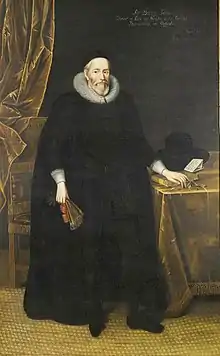| Main page | Indices | Projects |
The University of Oxford portal
The University of Oxford is a collegiate research university in Oxford, England. There is evidence of teaching as early as 1096, making it the oldest university in the English-speaking world and the world's second-oldest university in continuous operation. It grew rapidly from 1167, when Henry II banned English students from attending the University of Paris. After disputes between students and Oxford townsfolk in 1209, some academics fled north-east to Cambridge where they established what became the University of Cambridge. The two English ancient universities share many common features and are jointly referred to as Oxbridge.
The University of Oxford is made up of thirty-nine semi-autonomous constituent colleges, four permanent private halls, and a range of academic departments which are organised into four divisions. All the colleges are self-governing institutions within the university, each controlling its own membership and with its own internal structure and activities. All students are members of a college. It does not have a main campus, and its buildings and facilities are scattered throughout the city centre. Undergraduate teaching at Oxford consists of lectures, small-group tutorials at the colleges and halls, seminars, laboratory work and occasionally further tutorials provided by the central university faculties and departments. Postgraduate teaching is provided in a predominantly centralised fashion.
Oxford operates the Ashmolean Museum, the world's oldest university museum; Oxford University Press, the largest university press in the world; and the largest academic library system nationwide. In the fiscal year ending 31 July 2023, the university had a total consolidated income of £2.92 billion, of which £789 million was from research grants and contracts.
Oxford has educated a wide range of notable alumni, including 30 prime ministers of the United Kingdom and many heads of state and government around the world. 73 Nobel Prize laureates, 4 Fields Medalists, and 6 Turing Award winners have matriculated, worked, or held visiting fellowships at the University of Oxford, while its alumni have won 160 Olympic medals. Oxford is the home of numerous scholarships, including the Rhodes Scholarship, one of the oldest international graduate scholarship programmes. (Full article...)
Selected article

The university's position of Savilian Professor of Geometry was established in 1619. It was founded (at the same time as the Savilian Professorship of Astronomy) by Sir Henry Savile (pictured), a mathematician who was Warden of Merton College, reacting to what has been described as "the wretched state of mathematical studies in England" at that time. He appointed Henry Briggs as the first professor. There have been 19 geometry professors in all, with the most recent, Nigel Hitchin, appointed to the chair in 1997. Past professors include Edmond Halley, the astronomer, and Baden Powell, the father of the founder of the scout movement Robert Baden-Powell. Edward Titchmarsh (professor from 1931 to 1963) said when applying that he was not prepared to lecture on geometry, and the requirement was removed from the duties of the post to enable his appointment, although the title of the chair was not changed. The two Savilian chairs have been linked with professorial fellowships at New College since the late 19th century. Before then, for over 175 years until the middle of the 19th century, the geometry professors had an official residence adjoining the college in New College Lane. (Full article...)
Selected biography

Selected college or hall

Linacre College is a college for graduate students on St Cross Road, near the University Parks to the north-east of the city centre, and close to the university's science area. It was founded in 1962, originally as a non-residential and non-collegiate body called "Linacre House" to provide a base for graduates in Oxford. It moved to its present site in 1977, became financially independent of the university in 1980 and acquired full college status in 1986. The college is named after Thomas Linacre (1460–1524), a distinguished humanist, medical scientist and classicist. There are about 300 students in a range of subjects; many are from overseas, with over fifty different countries represented. Linacre was the first Oxford college to admit men and women on an equal basis. The principal is the botanist Nick Brown, appointed in 2009. There are about 50 Fellows, with former Fellows including the Nobel Prize winner Paul Nurse and the biologist Chris Dobson. Former students include the journalist Yasmin Alibhai-Brown, the literary critic Terry Eagleton and the Christian writer and academic Alister McGrath. (Full article...)
Selected image

Did you know
Articles from Wikipedia's "Did You Know" archives about the university and people associated with it:

- ... that John Prideaux Lightfoot commissioned the Adoration of the Magi tapestry (detail pictured) from Morris & Co. for the Gothic revival chapel at Exeter College, but died before it was completed?
- ... that special trains were laid on for voters returning to Oxford for the 1860 election of the Boden Professor of Sanskrit?
- ... that William Morfill was the first professor of Russian in Britain?
- ...that a scathing obituary of British author Lord Michael Pratt in The Daily Telegraph called him "an unabashed snob and social interloper on a grand scale", who habitually outstayed his welcome?
- ... that one 16th-century Registrar of the University of Oxford was dismissed after neglecting his duties for a year, then imprisoned and fined after throwing a punch when the debate had ended?
Selected quotation
Selected panorama
On this day
Events for 15 January relating to the university, its colleges, academics and alumni. College affiliations are marked in brackets.
Wikimedia
The following Wikimedia Foundation sister projects provide more on this subject:
-
 Commons
Commons
Free media repository -
 Wikibooks
Wikibooks
Free textbooks and manuals -
 Wikidata
Wikidata
Free knowledge base -
 Wikinews
Wikinews
Free-content news -
 Wikiquote
Wikiquote
Collection of quotations -
 Wikisource
Wikisource
Free-content library -
 Wikiversity
Wikiversity
Free learning tools -
 Wikivoyage
Wikivoyage
Free travel guide -
 Wiktionary
Wiktionary
Dictionary and thesaurus

